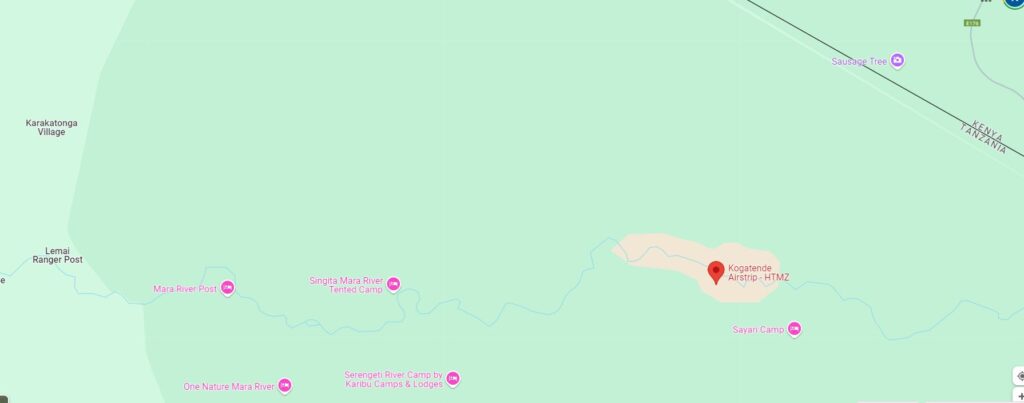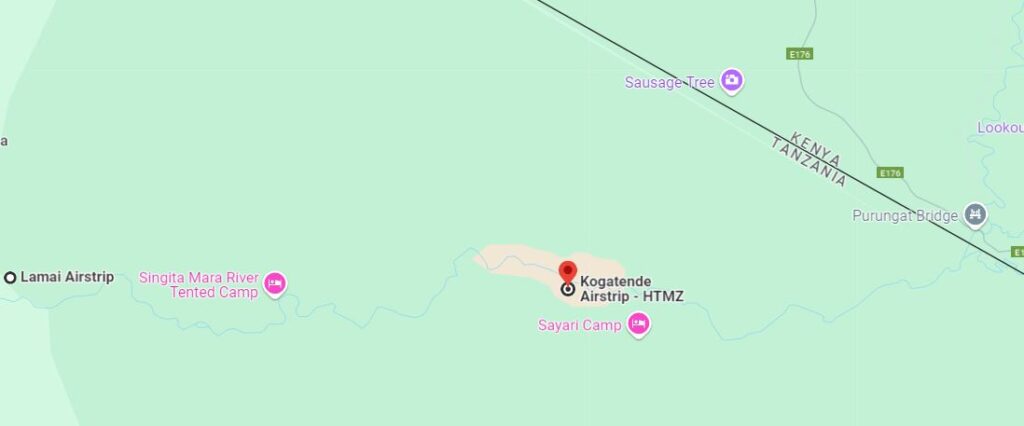The Serengeti Mara Area, located in the northernmost part of Serengeti National Park, is characterized by its iconic sloping grasslands that form a vital corridor for the Great Migration. These lush, undulating plains are wedged between the Mara River to the south and the Kenyan border to the north, leading directly into Kenya’s Masai Mara. This natural funnel makes the Serengeti Mara one of the most important and dramatic settings for the annual migration, as herds of wildebeest, zebras, and gazelles traverse the area in search of fresh grazing lands.
The map below shows a cluster of luxurious camps located along the Mara River, each offering a front-row seat to this unique wildlife theater. Some of the notable camps include:

- Mara River Post
- Singita Mara River Tented Camp
- Serengeti River Camp by Karibu Camps & Lodges
- One Nature Mara River
- Sayari Camp
These camps provide an immersive safari experience, with guests having the opportunity to witness the iconic river crossings and the wide range of wildlife that congregates near the river.
How to Access Serengeti Mara Area
Access to the Serengeti Mara area is facilitated through multiple routes. The Kogatende Airstrip serves as the primary access point, conveniently located near several camps, making air travel a favored option for those visiting this remote region. Additionally, the Lamai Ranger Post and Lamai Airstrip also serve as important entry points for visitors, allowing them to explore this corner of the Serengeti with ease.
Further south lies the Kogatende Rangers Post, which acts as a key checkpoint for visitors coming through this section of the park. The nearby villages and ranger stations provide essential services for those venturing into the wild, ensuring a smooth and well-guided safari experience.
The combination of luxurious accommodation, dramatic wildlife scenes, and easy access via airstrips makes the Serengeti Mara area a must-visit for anyone seeking an unforgettable experience in the heart of one of the world’s most famous ecosystems.
Specific Locations within Serengeti Mara:
- Kogatende: The Kogatende Rangers Post serves as a gateway to this northern region of the park. Access to the Serengeti Mara is achieved by crossing a concrete causeway over the Mara River, a critical point for observing the wildlife activity that surrounds the river, particularly during migration season. Kogatende is also famous for hosting quieter river crossings compared to the more crowded viewing points in Kenya’s Masai Mara.
- Lamai Wedge: Just west of the Mara River and bordering Kenya, the Lamai Wedge area features sweeping grasslands sloping gently toward the river. This wedge is an isolated pocket of Serengeti that offers outstanding game viewing opportunities with fewer tourists, making it ideal for observing the herds as they amass near the riverbanks.
- Mara River Crossing Points: As the herds navigate these sloping grasslands, they approach the infamous Mara River Crossing points where dangerous encounters with crocodiles and swift currents await. These grassy slopes provide the crucial run-up for the herds as they gather the courage to cross the river. During the migration season, the northern slopes of the Mara River become a gathering point, providing a natural amphitheater for witnessing the crossings.

The sloping grasslands of Serengeti Mara, with their panoramic views, not only facilitate the wildlife movements but also create a stunning backdrop for photography, making the area a highlight of any Serengeti safari. The transition from these slopes into the riverine forests around the Mara River further enriches the diversity of landscapes that visitors can enjoy.
How Serengeti Mara is Like During Great Migration
The Serengeti Mara landscape during the Great Migration is nothing short of awe-inspiring. Picture vast, rolling grasslands, punctuated by rocky outcrops and acacia trees, sloping gently down toward the winding Mara River. This seemingly endless sea of grass transforms into a stage for one of nature’s greatest spectacles.
From July to October, the golden plains are alive with movement, as hundreds of thousands of wildebeest, zebras, and gazelles blanket the landscape. The migration is a mass of energy, dust, and determination as the animals move in search of greener pastures, often shadowed by predators like lions, leopards, and hyenas waiting for an opportunity.
As the herds approach the Mara River, the landscape becomes a scene of tension and chaos. Steep, rugged banks border the river, with deep waters teeming with crocodiles lurking beneath the surface. The nervous wildebeest and zebras mill about on the edges of the riverbanks, hesitant but driven by the survival instinct to cross. When they finally plunge into the river, the landscape explodes with energy, a battle between life and death playing out against the backdrop of sweeping, untamed wilderness.
Around the river, the land remains lush thanks to the water source, making it a magnet for wildlife. Meanwhile, the surrounding savanna turns dry and dusty, emphasizing the stark contrast between the vibrant river zone and the parched plains. From the hills and elevated kopjes scattered across the Mara, the sheer magnitude of the migration, flowing like a wave across the land, can be seen from miles away, offering one of the most dramatic views in the Serengeti ecosystem.
Best Time to Visit
The best time to visit the Mara Serengeti Area is from July to October, when the herds of the Great Migration arrive in this northern part of the park, making their way towards the Masai Mara in Kenya. During this period, dramatic river crossings occur at the Mara River, one of the most spectacular wildlife events you can witness. Thousands of wildebeest plunge into the river, facing off against crocodiles and other predators. However, the Mara Serengeti is also a year-round destination with rich resident wildlife, so visiting during the shoulder months can provide a quieter but equally rewarding experience.
Wildlife in Mara Serengeti
The Mara Serengeti is a prime location for big game. In addition to the vast herds of wildebeest, zebra, and gazelle during the migration, it is home to a variety of predators, including:
- Lions: Numerous prides dominate the area, with some famous lion prides, such as the Black Rock Pride, known for their hunting prowess.
- Leopards: Often seen in the rocky outcrops and thickets, making for incredible photographic opportunities.
- Cheetahs: With their incredible speed, cheetahs take advantage of the open plains to hunt down gazelle and other prey.
- Hyenas and Jackals: These scavengers are often seen cleaning up the remnants after predator kills, contributing to the ecosystem’s health.
Other animals in the Mara include elephants, giraffes, buffalo, and even the elusive rhino, which can occasionally be spotted in the more remote areas.
Landscapes and Scenery
The Mara Serengeti offers a breathtaking mix of landscapes, including rolling grasslands, woodlands, and the winding Mara River. The river serves as the lifeblood of the area, not only for migrating animals but also for resident wildlife that rely on it year-round. The landscape is dotted with acacia trees, providing a stunning backdrop for game viewing, particularly in the golden light of early morning and late afternoon.
River Crossings and Predatory Drama
The river crossings in the Mara Serengeti Area are arguably the most dramatic moments of the Great Migration. As the herds gather at the riverbanks, they hesitate before making the perilous crossing, aware of the danger lurking in the water. The tension builds as more animals crowd the edges until, finally, a few brave wildebeest plunge into the water, followed by a stampede of thousands. It’s an adrenaline-packed spectacle, with crocodiles lying in wait and big cats like lions and leopards stalking the exhausted animals on the other side.
Avoiding the Crowds
While the Mara Serengeti is one of the most visited areas of the park during migration season, there are ways to avoid the crowds and enjoy a more intimate safari experience. Early morning game drives or exploring the less frequented parts of the northern Serengeti can provide exceptional wildlife encounters without the congestion of too many vehicles. Staying in remote camps or luxury lodges that offer exclusive access to certain areas can also enhance the experience, giving you the chance to witness nature in its rawest form, away from the busy tourist hotspots.
Accommodation and Accessibility
The Mara Serengeti offers a range of accommodations, from luxury lodges and tented camps to more basic camping options. Many of the lodges and camps are strategically placed near the river or within prime game viewing areas. Access to the area is relatively easy with airstrips located nearby, allowing for fly-in safaris from other parts of Tanzania or Kenya. Road access is also available, although the journey can be long and bumpy, especially during the rainy season.
Conclusion
The Mara Serengeti Area is the pinnacle of wildlife spectacle, especially during the Great Migration. Its combination of stunning landscapes, diverse wildlife, and unforgettable predator-prey interactions makes it a must-visit for anyone looking to experience one of the world’s greatest natural wonders. Whether you come for the river crossings, the rich predator populations, or the sheer beauty of the Serengeti, this area will leave you with memories to last a lifetime.
